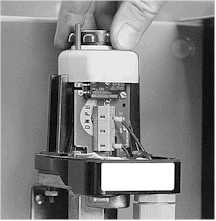<BR> Fig. 3.29: Pressure switch
Fig. 3.29: Pressure switch | Piston compressors are normally controlled by pressure switches. The pressure switches must be located in a calm area of the compressed air. This is in the compressed air receiver, for example, and not in the pipeline between the compressor and the receiver.
The pressure switch stops the compressor at maximum pressure and switches it back on at 20 % below maximum pressure. The actuation is therefore 8 :10 bar and 12 :15 bar.
A smaller differential is not recommended because the compressor will then cycle too often and the wear on the compressor and the motor increases. The cut-in pressure can be lowered with the cut-out pressure remaining constant. This has the advantage that the compressor has longer running times but longer stationary times too. The cut-in pressure may not be lower than the minimum pressure of the pneumatic network.
Piston compressors do not continue running (running-on) but switch off immediately after the maximum pressure is reached (intermittent operation).
Piston compressors are particularly suitable as peak load machines. The compressor only switches on when there is an increased demand for compressed air and switches off without run-on time when the maximum pressure is reached, i.e., saving approx. 30 % energy consumption in idling mode. |